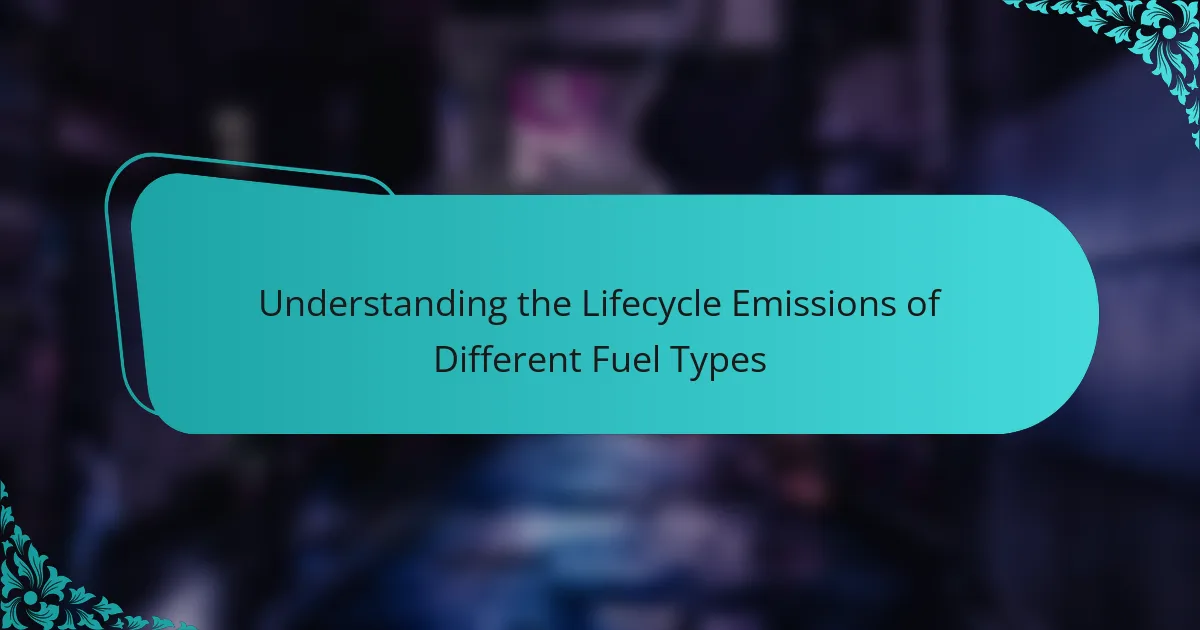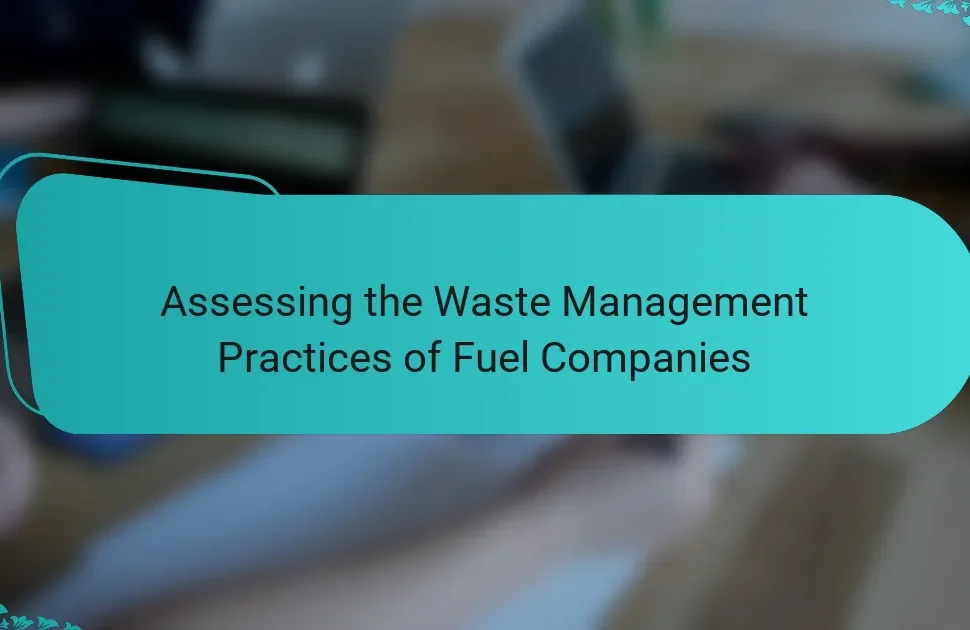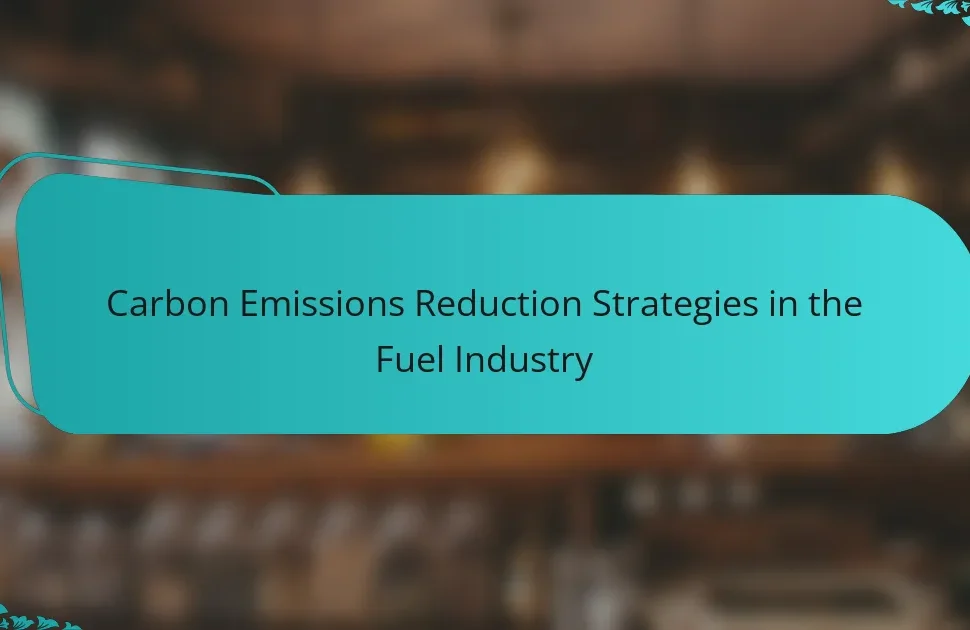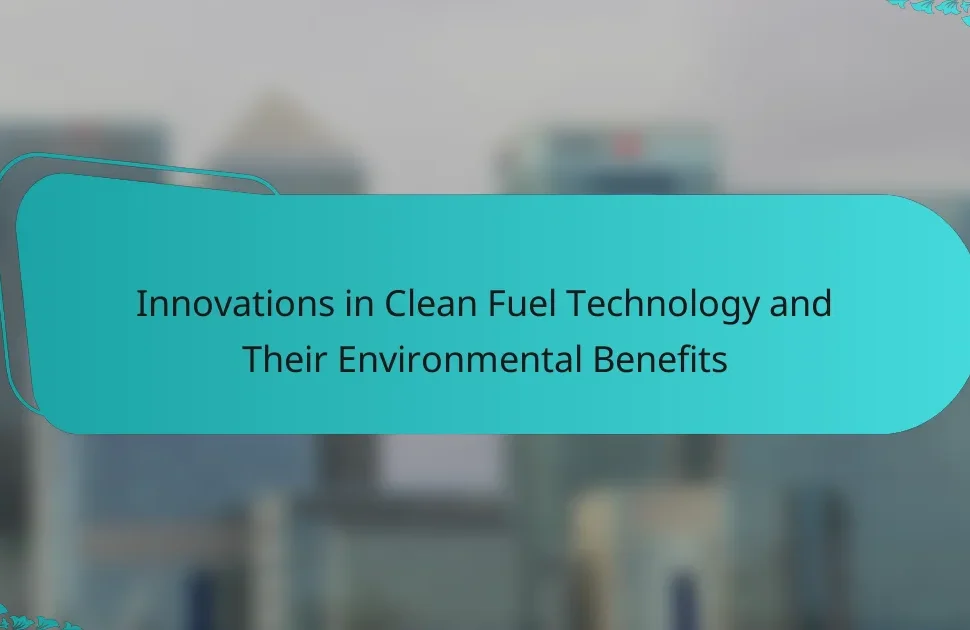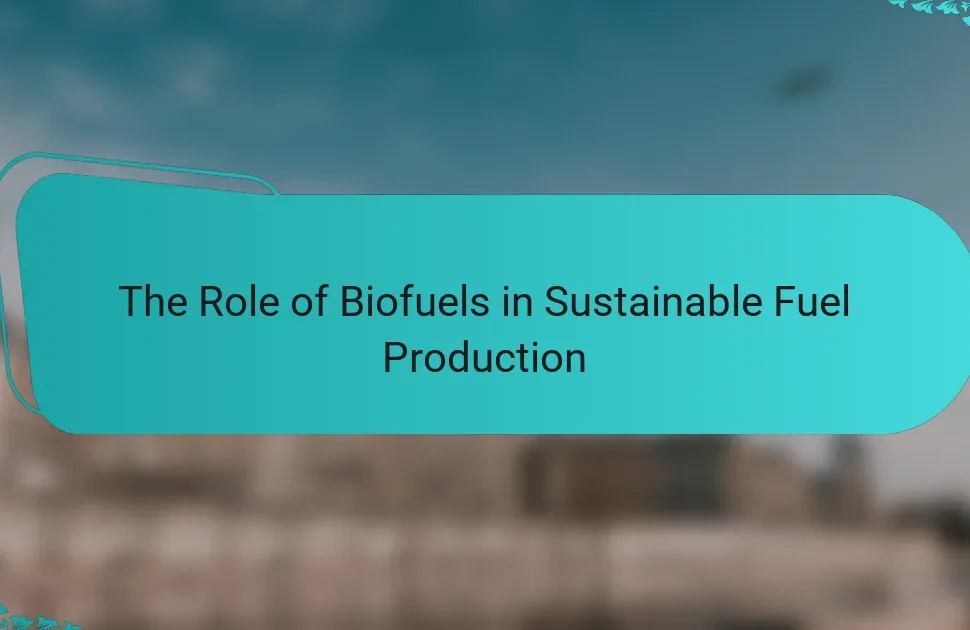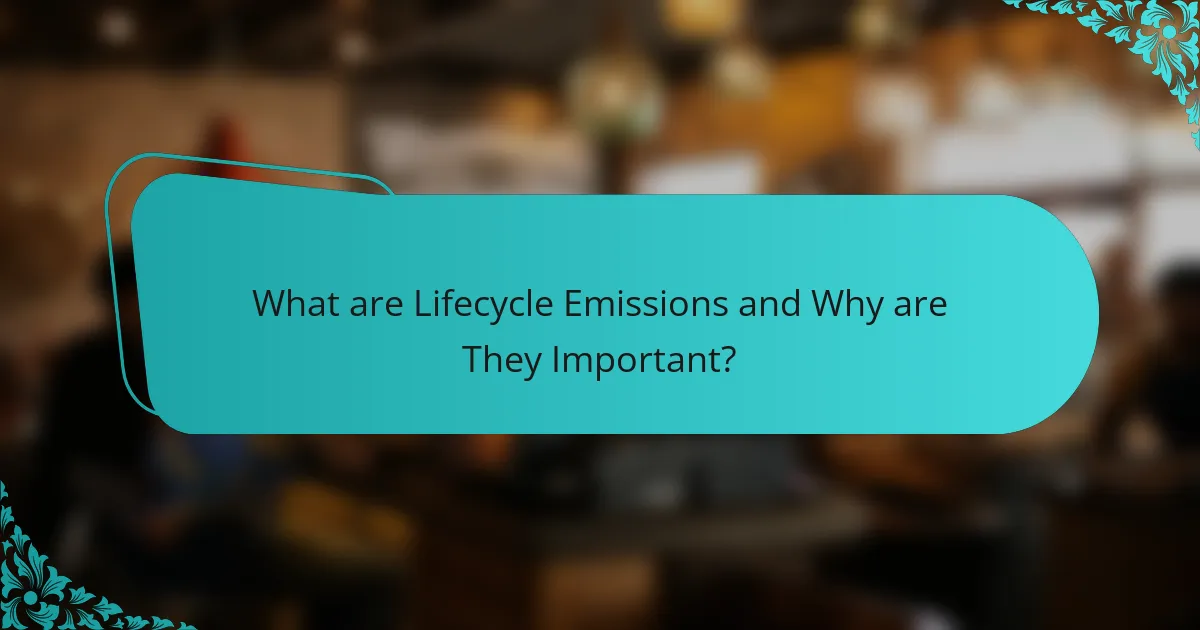
What are Lifecycle Emissions and Why are They Important?
Lifecycle emissions refer to the total greenhouse gas emissions produced throughout the entire lifecycle of a product or fuel. This includes emissions from extraction, production, transportation, use, and disposal. Understanding lifecycle emissions is crucial for assessing the environmental impact of different fuel types. It helps in making informed decisions about energy sources and policies aimed at reducing carbon footprints. Studies show that lifecycle assessments can reveal significant differences in emissions among fuels. For instance, renewable energy sources often have lower lifecycle emissions compared to fossil fuels. This information is vital for developing strategies to mitigate climate change.
How are Lifecycle Emissions Defined?
Lifecycle emissions are defined as the total greenhouse gas emissions associated with a product throughout its entire life cycle. This includes emissions from raw material extraction, production, transportation, use, and disposal. Each phase contributes to the overall carbon footprint of the product. For example, fossil fuels release significant emissions during extraction and combustion. Studies show that lifecycle assessments can reveal the true environmental impact of different fuel types. These assessments help in comparing the sustainability of alternatives like biofuels versus conventional fuels. Understanding lifecycle emissions is crucial for informed decision-making in energy policy and climate action.
What stages are included in the Lifecycle Emissions of fuel types?
The lifecycle emissions of fuel types include several distinct stages. These stages are extraction, production, transportation, refining, distribution, and combustion.
Extraction involves the removal of raw materials from the environment. Production refers to the processes that convert raw materials into usable fuels. Transportation covers the movement of fuels from production sites to refineries or distribution centers.
Refining is the process of transforming crude fuels into usable forms. Distribution includes the delivery of fuels to retail outlets or end-users. Finally, combustion is the burning of fuels for energy, which generates emissions.
Each stage contributes to the overall emissions associated with a specific fuel type.
Why is understanding Lifecycle Emissions crucial for environmental impact assessments?
Understanding Lifecycle Emissions is crucial for environmental impact assessments because it provides a comprehensive view of the total emissions associated with a product or process. Lifecycle Emissions encompass all stages, from raw material extraction to disposal. This holistic approach allows for better identification of environmental impacts. It helps in comparing different fuel types accurately. For instance, fossil fuels typically have higher lifecycle emissions than renewable energy sources. This understanding guides policymakers in making informed decisions. It also aids industries in improving sustainability practices. By assessing lifecycle emissions, stakeholders can prioritize actions that reduce overall environmental harm.
What Factors Influence Lifecycle Emissions of Different Fuel Types?
Lifecycle emissions of different fuel types are influenced by several key factors. These factors include the extraction process, transportation methods, refining techniques, and end-use combustion efficiency. Each fuel type has a unique extraction impact. For instance, fossil fuels often have high emissions during extraction due to equipment and processes involved. Transportation also contributes significantly. Fuels transported over long distances can incur higher emissions from shipping and logistics. Refining processes vary in energy intensity. Some fuels require more energy to refine, leading to increased lifecycle emissions. Finally, the combustion efficiency of the fuel impacts total emissions produced during use. More efficient fuels produce fewer emissions per unit of energy generated. These factors collectively determine the overall lifecycle emissions associated with each fuel type.
How do extraction and production processes affect emissions?
Extraction and production processes significantly affect emissions by determining the amount of greenhouse gases released. These processes include drilling, mining, and refining, each contributing to carbon dioxide and methane emissions. For example, natural gas extraction can lead to methane leaks, a potent greenhouse gas. Oil production involves flaring, which releases carbon dioxide into the atmosphere. The energy required for extraction also contributes to emissions, as fossil fuels are often burned to power machinery. A study by the Environmental Protection Agency found that oil and gas operations accounted for about 30% of methane emissions in the U.S. This data highlights the direct correlation between extraction methods and overall emissions levels.
What role do transportation and distribution play in emissions profiles?
Transportation and distribution significantly contribute to emissions profiles. They account for a substantial portion of greenhouse gas emissions in supply chains. According to the U.S. Environmental Protection Agency, transportation contributes about 29% of total greenhouse gas emissions in the United States. This includes emissions from freight and passenger transport. The type of fuel used in transportation also affects emissions levels. For example, diesel trucks emit more CO2 than electric vehicles. Additionally, the distance goods travel impacts overall emissions. Longer distances typically result in higher emissions due to increased fuel consumption. Efficient logistics and alternative fuel sources can reduce these emissions effectively.
How Do Different Fuel Types Compare in Terms of Lifecycle Emissions?
Different fuel types vary significantly in lifecycle emissions. Lifecycle emissions encompass all greenhouse gases emitted during fuel extraction, production, distribution, and consumption. For instance, gasoline emits approximately 8.89 kg of CO2 per gallon burned. In contrast, diesel fuel emits about 10.16 kg of CO2 per gallon.
Natural gas has lower emissions, releasing about 5.3 kg of CO2 per therm. Renewable fuels, such as biofuels, can have variable emissions based on production methods. For example, corn-based ethanol may emit around 2.5 kg of CO2 per gallon, while advanced biofuels can be even lower.
Electric vehicles’ emissions depend on the electricity source. If powered by coal, emissions can be higher than gasoline. However, if powered by renewables, lifecycle emissions can be significantly reduced. Studies show that electric vehicles can produce up to 60% less emissions compared to traditional vehicles when sourced from renewable energy.
Overall, fossil fuels generally have higher lifecycle emissions compared to renewable and alternative fuels. The choice of fuel type directly impacts overall greenhouse gas emissions.
What are the emissions profiles of fossil fuels compared to renewable energy sources?
Fossil fuels have significantly higher emissions profiles compared to renewable energy sources. The combustion of fossil fuels releases carbon dioxide (CO2), methane (CH4), and nitrous oxide (N2O), which are major greenhouse gases. For instance, burning coal emits about 2.2 pounds of CO2 per kilowatt-hour generated. In contrast, renewable energy sources like wind, solar, and hydro produce minimal to zero direct emissions during operation. A report from the International Renewable Energy Agency indicates that renewables can reduce greenhouse gas emissions by up to 70% compared to fossil fuels. Lifecycle assessments show that fossil fuel extraction, processing, and burning contribute to a much larger carbon footprint than the lifecycle of renewable energy technologies.
How do alternative fuels like biofuels and hydrogen measure up?
Biofuels and hydrogen are alternative fuels that offer varying environmental benefits. Biofuels are derived from organic materials and can reduce greenhouse gas emissions by up to 80% compared to fossil fuels. Hydrogen, when produced from renewable sources, emits only water vapor during combustion, making it a zero-emission fuel.
Lifecycle emissions for biofuels include emissions from cultivation, processing, and transport. Studies show that biofuels can have a lower carbon footprint than traditional fuels when considering these factors. Hydrogen production methods, such as electrolysis using renewable energy, can further minimize emissions.
The U.S. Department of Energy reports that hydrogen can achieve up to 60% lower lifecycle emissions compared to gasoline. Both fuels present opportunities for reducing reliance on fossil fuels while addressing climate change.
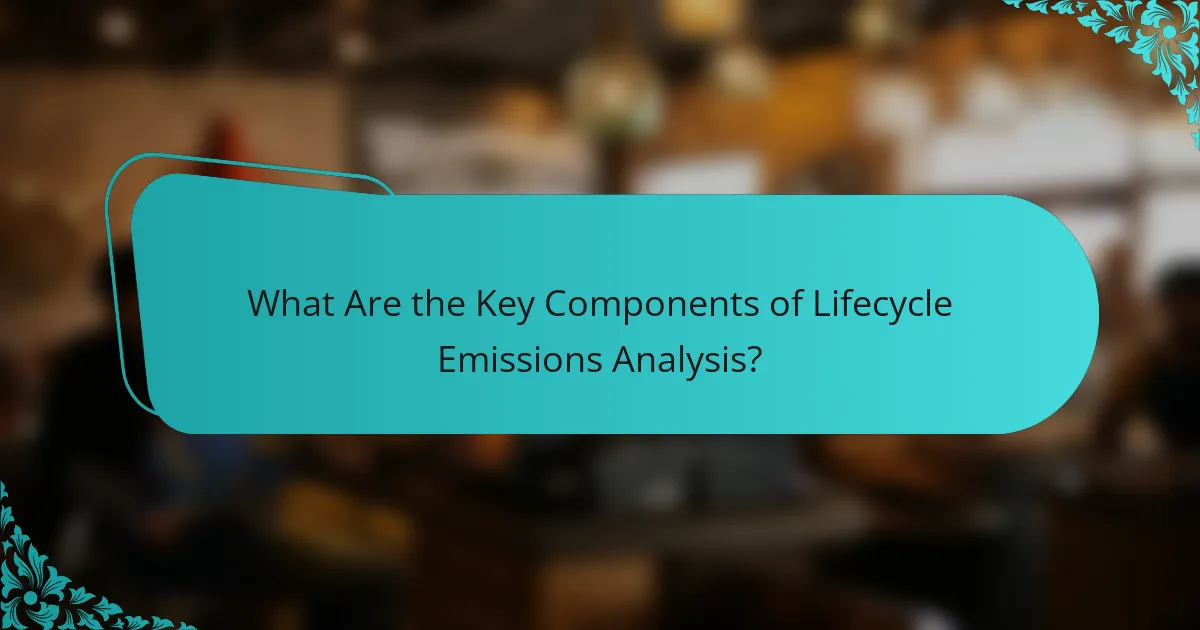
What Are the Key Components of Lifecycle Emissions Analysis?
The key components of lifecycle emissions analysis include raw material extraction, production, transportation, usage, and disposal phases. Each phase contributes to the total greenhouse gas emissions associated with a product or fuel type. For instance, raw material extraction involves emissions from mining or harvesting. Production emissions stem from manufacturing processes and energy consumption. Transportation emissions occur during the movement of materials and products. Usage emissions are generated when the product is utilized, particularly in energy applications. Finally, disposal emissions arise from the end-of-life treatment of the product. Comprehensive lifecycle assessments quantify these emissions to inform sustainability decisions.
What methodologies are used to assess Lifecycle Emissions?
Lifecycle emissions assessment methodologies include Life Cycle Assessment (LCA), carbon footprint analysis, and input-output analysis. LCA evaluates the environmental impacts of a product through its entire life cycle. This includes raw material extraction, production, use, and disposal phases. Carbon footprint analysis specifically measures greenhouse gas emissions associated with a product. Input-output analysis examines the interdependencies between different sectors of the economy to estimate emissions. Each methodology provides distinct insights into the environmental impact of fuel types. These methodologies are widely recognized in environmental science and sustainability studies. They facilitate informed decision-making regarding fuel usage and policy development.
How do life cycle assessment (LCA) frameworks work?
Life cycle assessment (LCA) frameworks evaluate the environmental impacts of a product throughout its entire life cycle. This includes stages such as raw material extraction, production, use, and disposal. LCA frameworks systematically analyze resource consumption and emissions at each stage. They quantify impacts like greenhouse gas emissions, energy use, and resource depletion. Data is collected for each life cycle stage to assess overall sustainability. LCA methodologies follow standards like ISO 14040 and ISO 14044. These standards ensure consistency and reliability in assessments. By comparing different products or processes, LCA frameworks help identify opportunities for reducing environmental impacts.
What data sources are essential for accurate emissions calculations?
Essential data sources for accurate emissions calculations include fuel consumption data, emission factors, and activity data. Fuel consumption data provides the quantity of fuel used, which is critical for determining emissions. Emission factors are coefficients that relate the amount of emissions produced to the amount of fuel consumed. These factors vary by fuel type and are based on empirical research. Activity data reflects the operational context, such as distance traveled or production levels, influencing total emissions. Additionally, government and industry reports, peer-reviewed studies, and databases like the EPA’s Inventory of U.S. Greenhouse Gas Emissions and Sinks provide reliable emission factors and methodologies. Accurate emissions calculations depend on the integration of these data sources for comprehensive assessments.
What Challenges Are Associated with Measuring Lifecycle Emissions?
Measuring lifecycle emissions presents several challenges. One major challenge is data availability. Comprehensive data on emissions across all lifecycle stages is often lacking. This includes extraction, production, transportation, and disposal phases. Another challenge is variability in methodologies. Different organizations may use varied approaches to calculate emissions, leading to inconsistent results. Additionally, assumptions made during calculations can significantly impact outcomes. Factors such as energy inputs, transportation distances, and technology used can vary widely. Uncertainty in emission factors also complicates measurements. Emission factors can change based on conditions and technologies, leading to potential inaccuracies. Lastly, the dynamic nature of regulations and standards can affect measurement consistency. Changes in environmental policies may alter how emissions are calculated and reported. These challenges collectively hinder accurate lifecycle emissions assessments.
What uncertainties exist in emissions data collection?
Uncertainties in emissions data collection include variability in measurement methods. Different techniques can yield varying results, leading to discrepancies. Inaccuracies in reporting can stem from self-reported data from companies. These reports may lack verification, resulting in potential underreporting or overreporting. Additionally, emissions factors used in calculations can be outdated or not representative of actual conditions. Geographic and temporal variations can also affect data accuracy. For instance, emissions from a specific fuel type can differ based on location and time of use. Lastly, incomplete data sets may arise from gaps in monitoring infrastructure. These uncertainties highlight the need for standardized protocols in emissions data collection.
How do regional differences impact emissions assessments?
Regional differences significantly impact emissions assessments by influencing the sources of energy and transportation methods used. Each region has unique energy profiles, with varying reliance on fossil fuels, renewables, and nuclear energy. For example, regions rich in coal may report higher emissions than those utilizing hydroelectric power. Additionally, local regulations and policies can affect emissions reporting and reduction strategies. Climate conditions also play a role; colder regions may have higher heating emissions. According to the U.S. Environmental Protection Agency, emissions factors vary by region due to these differences. Regional economic activities further contribute to emissions variations, as industrialized areas may produce more emissions than rural regions.
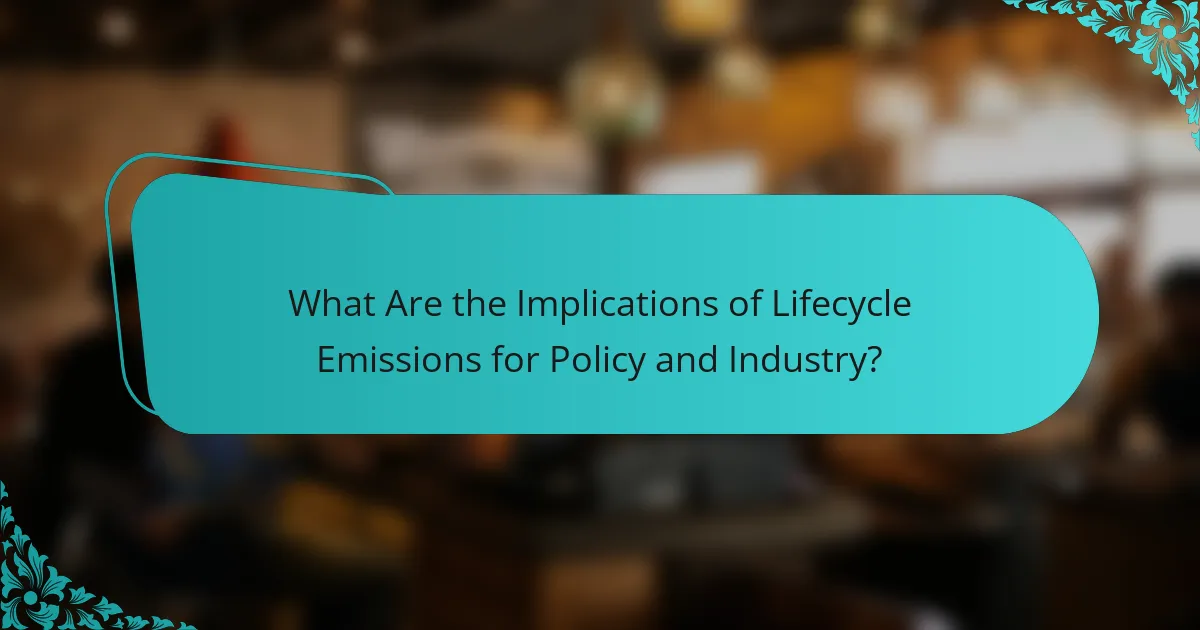
What Are the Implications of Lifecycle Emissions for Policy and Industry?
Lifecycle emissions significantly influence policy and industry practices. They inform regulatory frameworks aimed at reducing greenhouse gas emissions. Policymakers use lifecycle assessments to evaluate the total environmental impact of fuel types. This includes extraction, production, use, and disposal phases. Industries are encouraged to adopt cleaner technologies based on these assessments. For instance, the Renewable Fuel Standard in the U.S. incentivizes low-emission fuels. Lifecycle emissions data can also drive investment in sustainable energy solutions. Thus, accurate measurement of lifecycle emissions shapes effective environmental policies and industry standards.
How can Lifecycle Emissions data inform policy decisions?
Lifecycle emissions data can inform policy decisions by providing comprehensive insights into the environmental impact of various fuel types. This data tracks emissions from production to disposal, highlighting the total carbon footprint associated with each fuel. Policymakers can use this information to identify cleaner alternatives and promote sustainable practices. For instance, studies show that biofuels often have lower lifecycle emissions compared to fossil fuels, influencing regulations and subsidies. Additionally, lifecycle assessments can reveal the benefits of transitioning to renewable energy sources. By understanding these emissions, governments can set more effective climate targets and regulations. Accurate data helps in assessing trade-offs and making informed decisions that align with environmental goals.
What regulations are influenced by understanding Lifecycle Emissions?
Understanding lifecycle emissions influences regulations related to carbon emissions, fuel efficiency, and environmental impact assessments. These regulations aim to reduce greenhouse gas emissions and promote sustainable practices. For example, the Clean Air Act in the United States regulates air pollutants, which includes emissions from fuel combustion. The European Union’s Renewable Energy Directive sets targets for renewable energy use and mandates lifecycle assessments for biofuels. Additionally, the California Air Resources Board implements regulations based on lifecycle emissions to achieve climate goals. These regulations are informed by comprehensive data on the environmental impacts of various fuel types throughout their lifecycle.
How do companies use emissions data for sustainability initiatives?
Companies use emissions data to guide their sustainability initiatives. They analyze this data to identify key areas for reducing greenhouse gas emissions. This helps in setting measurable targets for emissions reductions. Companies often benchmark their performance against industry standards. They can also track progress over time to ensure accountability. Emissions data informs decisions about energy efficiency improvements and renewable energy investments. Additionally, it supports compliance with regulations and enhances corporate social responsibility efforts. By sharing emissions data, companies can engage stakeholders and improve transparency. This approach ultimately drives innovation and fosters a culture of sustainability within organizations.
What Best Practices Should Be Followed for Reducing Lifecycle Emissions?
Implementing best practices for reducing lifecycle emissions involves several strategies. First, optimizing energy efficiency in production processes is crucial. This can lead to lower energy consumption and reduced emissions. Second, utilizing renewable energy sources minimizes reliance on fossil fuels. Research shows that transitioning to solar or wind energy can significantly cut emissions. Third, improving transportation logistics reduces fuel consumption. Efficient routing and load optimization can lead to lower emissions during distribution. Fourth, adopting sustainable materials in product design lowers the carbon footprint. Studies indicate that using recycled or bio-based materials can decrease lifecycle emissions. Finally, promoting product longevity through design can reduce the frequency of replacements, thus lowering overall emissions. These practices collectively contribute to a significant reduction in lifecycle emissions across various fuel types.
How can industries implement strategies to lower emissions across the lifecycle?
Industries can implement strategies to lower emissions across the lifecycle by adopting sustainable practices. These practices include improving energy efficiency in production processes. For example, energy-efficient machinery can reduce fuel consumption significantly. Transitioning to renewable energy sources is another effective strategy. Using solar or wind energy can drastically cut emissions during production.
Additionally, optimizing supply chain logistics minimizes transportation emissions. Implementing a circular economy approach reduces waste and encourages recycling. This method can lower emissions associated with raw material extraction and processing.
Regularly assessing and reporting emissions helps track progress and identify areas for improvement. According to the World Resources Institute, companies that actively manage emissions can achieve a 20-30% reduction over time. These strategies collectively contribute to a significant decrease in lifecycle emissions.
What role do consumers play in influencing the lifecycle emissions of fuel types?
Consumers significantly influence the lifecycle emissions of fuel types through their purchasing choices and consumption patterns. By opting for low-emission fuels, consumers drive demand for cleaner energy sources. This demand can lead to increased production and investment in renewable technologies. Conversely, choosing high-emission fuels can perpetuate their market dominance. Research indicates that consumer preferences can shift market trends, impacting emissions at various lifecycle stages. For example, a study by the International Energy Agency found that consumer behavior directly affects fuel production and distribution emissions. Thus, consumer decisions play a crucial role in shaping the environmental impact of fuel types.
Lifecycle emissions represent the total greenhouse gas emissions generated throughout the entire lifecycle of various fuel types, encompassing extraction, production, transportation, usage, and disposal. This article examines the significance of understanding lifecycle emissions for assessing the environmental impact of fuels, highlighting the differences between fossil fuels and renewable energy sources. It details the factors influencing emissions, methodologies for assessment, and the implications for policy and industry practices. Additionally, the article outlines strategies for reducing lifecycle emissions and the critical role of consumer choices in shaping fuel consumption patterns.
